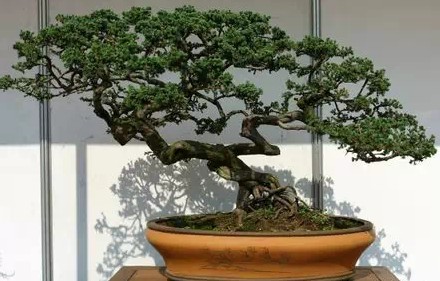Bonsai Art of Lingnan Culture
When it comes to Lingnan culture, people naturally think of Guangdong music, Cantonese opera, Cantonese cuisine, Lingnan painting school, Lingnan architecture, and talk about Lingnan folk art. They only talk about color, embroidery, tooth carving, jade carving, and so on, but seldom mention Lingnan bonsai. All these are undoubtedly the quintessence of Lingnan culture or Lingnan folk art, but if Lingnan bonsai is forgotten or even abandoned, I think it is not only not comprehensive but also a great pity for Lingnan culture.

Lingnan bonsai, like other schools, is an important branch of Chinese garden art and a relatively independent category of art. It is "silent poetry, three-dimensional painting". It belongs to image art like poetry, book, painting, sculpture and photography, but it is also a living art. It comprehensively uses the knowledge of horticulture, aesthetics, biology, literature and other disciplines, and is the combination of beauty and power, emotion and scenery, matter and reason.
1. Determined selection of materials
Because of its billet, the root is stable, the root spreads in all directions, the trunk texture is mottled and there are some holes, and there are three main branches protruding. The author according to its pile blank has the characteristics of old and stable. Position it as an oblique triangle composition, high on the right and low on the left. Form a pattern that the left is heavy and the right is light.
2. Production
The work adopts the technique of storing branches and truncating, shrinking the dragon into inches, and cultivating the main branches into the top technique of natural transition of trunk thickness and the twig-making techniques of antlers and chicken claws in the Lingnan School, with hard horns and soft horns interlaced, branches buckling and extending forward, and the branches are beginning to take shape after decades of time.
3. Style and its aesthetic feeling
Through the observation of the stable foundation of the whole work, the rugged and domineering backbone, and its moral branches, it gives people a kind of vigorous and vigorous, steady movement, chic and refined artistic beauty.
Time: 2019-06-04 Click:
- Prev

Zhao Qingquan, a master of Chinese bonsai art, shows the world the Yang bonsai
There is no eye-catching signboard hanging high, no luxurious decoration, hidden in the thin West Lake Wanhua Garden bonsai museum corner of Master Zhao Qingquan studio appears quite simple and low-key. When this reporter walked into Chao Ching-chuen's office, he was talking to Su Yi-chi, former president of the International Potted Plant Association and a famous Taiwan potted plant stone appreciator, by telephone.
- Next

The technical features and artistic style of Lingnan bonsai
Lingnan bonsai is mainly composed of tree stumps, which was produced in the 1930s and 1940s. Lingnan is located in the subtropics, with abundant rainfall and spring all the year round, which is suitable for plant growth. In history, Guangzhou is an early open trade port with an open mind and an inclusive culture. Weather, geography, humanities, history and other reasons
Related
- Fuxing push coffee new agricultural production and marketing class: lack of small-scale processing plants
- Jujube rice field leisure farm deep ploughing Yilan for five years to create a space for organic food and play
- Nongyu Farm-A trial of organic papaya for brave women with advanced technology
- Four points for attention in the prevention and control of diseases and insect pests of edible fungi
- How to add nutrient solution to Edible Fungi
- Is there any good way to control edible fungus mites?
- Open Inoculation Technology of Edible Fungi
- Is there any clever way to use fertilizer for edible fungus in winter?
- What agents are used to kill the pathogens of edible fungi in the mushroom shed?
- Rapid drying of Edible Fungi

